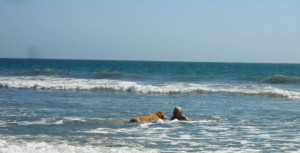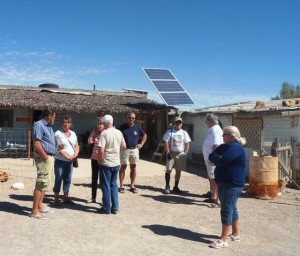
March 14, 2014 – That is what the Municipal Policeman said as he had me over the hood of his truck and was putting the handcuffs on. Clearly my strategy of intervening in his attempt to get one of our RVers to pay up $100 US for alleging running a red light in the community of Maneadero had some flaws. We had just driven through Maneadero heading south on Hwy 1 after leaving the campground in Punta Banda, something we have done many, many times. The town is relatively small with a couple of lights and many stop signs. As per usual we just crawl through the town, letting all would be passers get by us and at the same time keeping ourselves together before hitting the open road. Just as we had cleared the last stop sign we hear from Darrel & Nancie in the last RV (#7) that they have a Policeman wanting to pull them over with lights on. I look in the mirror and sure enough it is so, I asked them if they had ran a light or stop sign and they said no. As the last RV in the Caravan they had reported many “stopped at a red light” coming thru Ensenada, why would this suddenly change now I thought, particularly since everyone was easily in sight. I had everyone stay together and pull off the road, even off the shoulder. I quickly made my way back to their RV with a couple of others including Alison who speaks better Spanish then me. It was apparent to everyone quickly that this public servant was not up for any discussion or conversation about what was happening.We found him to be very aggressive (my opinion and others), someone described him as a thug. After asking him a couple of questions I decided to take a photo, always good to record these kind of events. This did not go over well and faster than you could say “hasta la vista baby” I was put in cuffs and sitting in the police truck with my hands behind my back. The good news was I had bought some time for Lisa to call a friend, (life line I think they refer to it as) who is a real goodwill ambassador for Mexico and has lots of experience with the local bureaucracy. Before you knew it Mr. Policia was talking to our contact on our cell phone who was explaining the positive merits of following the Baja California Governor’s directive to be proactive assisting tourists in distress and always exhibiting the friendliest attitude possible. Presto I was released, Darrel had his Driver`s License returned, the $100 demand a distant memory, the Police departed stage left and we were on our way. This was the first incident of this kind ever since 1985 traveling in Mexico and we continue to have respect for all the Mexican authorities. However as we know just like at home there are some bad apples in every barrel. At Baja Amigos we promise two (2) things, fun & adventure and yes, they are two (2) different words!

Onwards we traveled to Fidel’s, south of Lazaro Cardenas on the beach. The driving was busy and a little hectic however we made it without incident, no more arrests or police stops. Fidel was waiting for us and had lots of firewood delivered, we had also scrounged up a number of pieces left behind at Potrero by a large group that had been there earlier. Brenda went for a dip but alas no one joined her, although the surf was up! Many went for a nice beach walk and the gang had hot dogs over a good campfire.

The next day off we went to Catavina, another uneventful day; our stops included the Onyx Cafe operated by Luis & Lisa, a nice young couple with two very cute kids. After a few purchases we departed to Rancho Santa Inez, our final destination. Our excursion is to the local cave paintings, a bit of a hike but well worth the look. Later Darrel & Nancie hosted a movie night featuring The Hustle.

Today we drove to Guerrero Negro, after set up we headed to Tony`s Tacos and some grocery shopping. This evening we are celebrating Lorna`s birthday at the Malarrimo Restaurant, this will be lots of fun for sure. Tomorrow the group goes whale watching, currently over 1000 in Scammon`s Lagoon, then in the afternoon we depart to San Ignacio.
Did you know?
A Mexican Piñata (PIN-YATA) is a container often made of papier-mâché, pottery, or cloth and decorated, filled with toys and/or candy, and then broken as part of a ceremony or celebration. Piñatas are most commonly associated with Mexico, but its origins are considered to be in China.

Marco Polo first discovered the Chinese fashioning figures of cows, oxen or buffaloes, covered with colored paper and adorned with harnesses and trappings. Special colors traditionally greeted the New Year. When the mandarins knocked the figure hard with sticks of various colors, seeds spilled forth. After burning the remains, people gathered the ashes for good luck throughout the year. When this custom passed into Europe in the 14th century, it adapted to the celebrations of Lent. The first Sunday became ‘Piñata Sunday’. The Italian word ‘pignatta’ means “fragile pot.” Originally, piñatas fashioned without a base resembled clay containers for carrying water. Some say this is the origin of the traditional pineapple shape. Also the Latin prefix ‘piña’ implies a cluster of flowers or fruits as in ‘pineapples’ and ‘pine cones’.

The Spanish subsequently brought the European tradition to Mexico, although there were similar traditions in Mesoamerica. The Aztecs had a similar tradition to honor the birthday of the god Huitzilopochtli in mid December. According to local records, the Mexican piñata tradition began in the town of Acolman, just north of Mexico City, where piñatas were introduced for catechism purposes as well as to co-opt the Huitzilopochtli ceremony. They covered the traditional pot with colored paper, giving it an extraordinary, perhaps fearful appearance. Today, the piñata is still part of Mexican culture, the cultures of other countries in Latin America, as well as the United States, but it has mostly lost its religious character. Most people think of piñatas as a fun activity for parties. The history of the piñata reveals many interesting facts that go beyond the playing of a game, although piñatas certainly have been intended for fun.

The piñata remains most strongly identified with Mexico. The art of making modern piñatas falls under the Mexican craft heading of “cartonería“, which refers to the making of items from paper and cardboard. This puts piñatas in the same category as amate paper craf, Judas figures and Mexico City style alebrijes. The Museo de Arte Popular held the first “Concurso de Piñatas Mexicanas” (Mexican Piñata Contest) in 2007 with prizes of 15,000, 10,000 and 5,000 pesos. The purpose of the contest is to help retain this tradition and help it to be continued to be valued. The Galería de Historia-Museo del Caracol in Mexico City held a workshop on how to make traditional piñatas, as part of its outreach program to the public.

While the religious significance has been mostly lost, the current ceremony has remained mostly intact. Piñatas remain most popular during Las Posadas with birthday parties coming in second. Each participant, usually a child, will have a turn at hitting the piñata, which is hung from above on a string. The participant is blindfolded, given a wooden stick, and then spun a number of times. As the participants works to hit the piñata, another moves it to make it harder to hit. There is a time limit to any one person’s attempts, which is marked out by the singing of a traditional song.

Piñatas today come in all shapes and sizes, with many representing cartoon or other characters known to most children. Popular shapes today can include Batman, Superman, Spiderman or characters based on popular movies and television shows such as Nemo, the Lion King and more. For Christmas, the traditional style with the points is popular as it is associated with the Star of Bethlehem. However, for the most part, piñata designs have been completely commercialized. Traditionally in Mexico, especially at Christmas, piñatas are filled with fruit and candies such as guavas, oranges, jicamas, pieces of sugar cane, tejocotes and wrapped candies. Some piñatas are “traps” filled with flour, confetti or water. Special baskets of treats may be given to children who come up empty handed after a piñata is broken. These are called colaciónes and are given to prevent hurt feelings.



